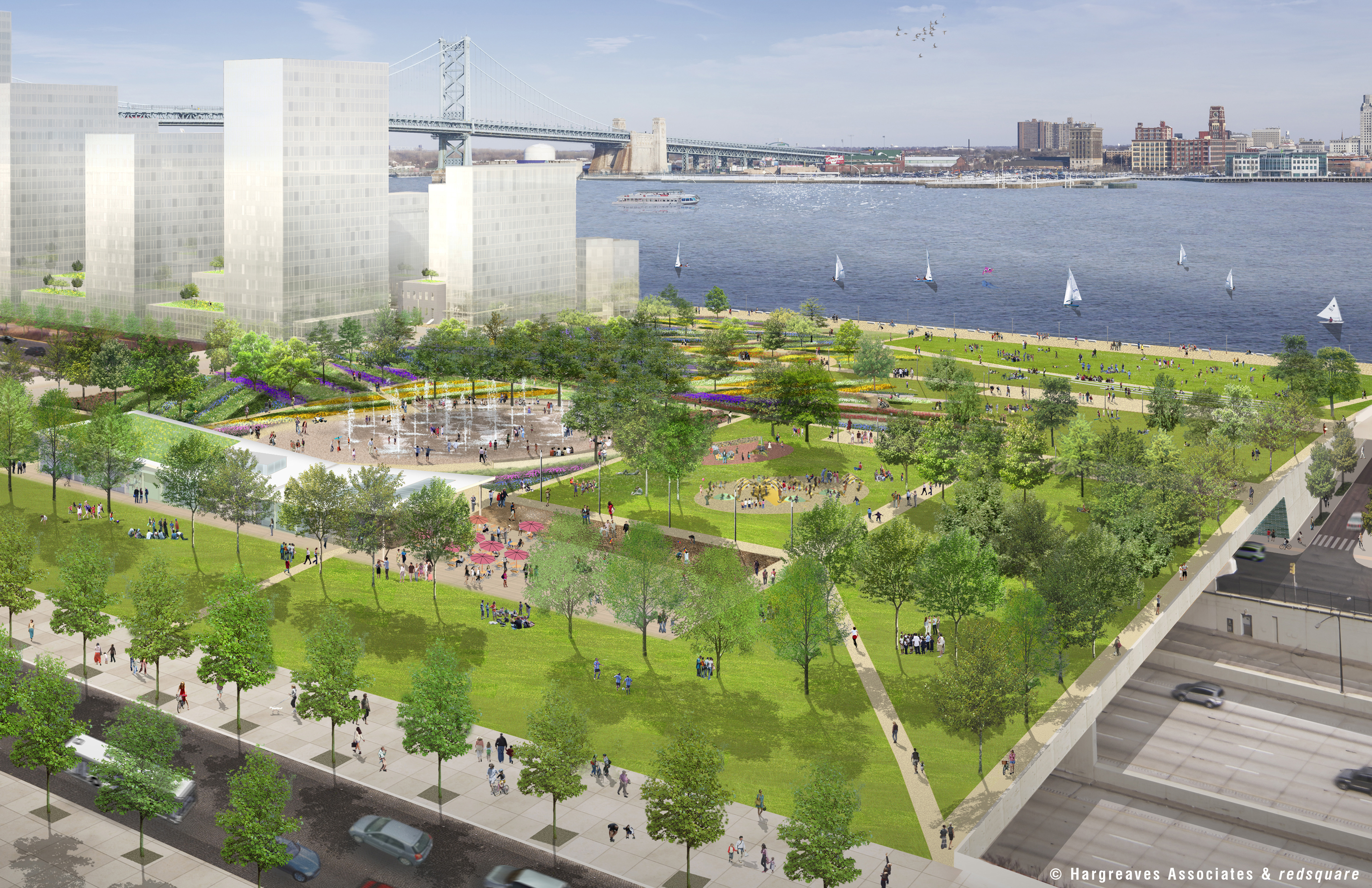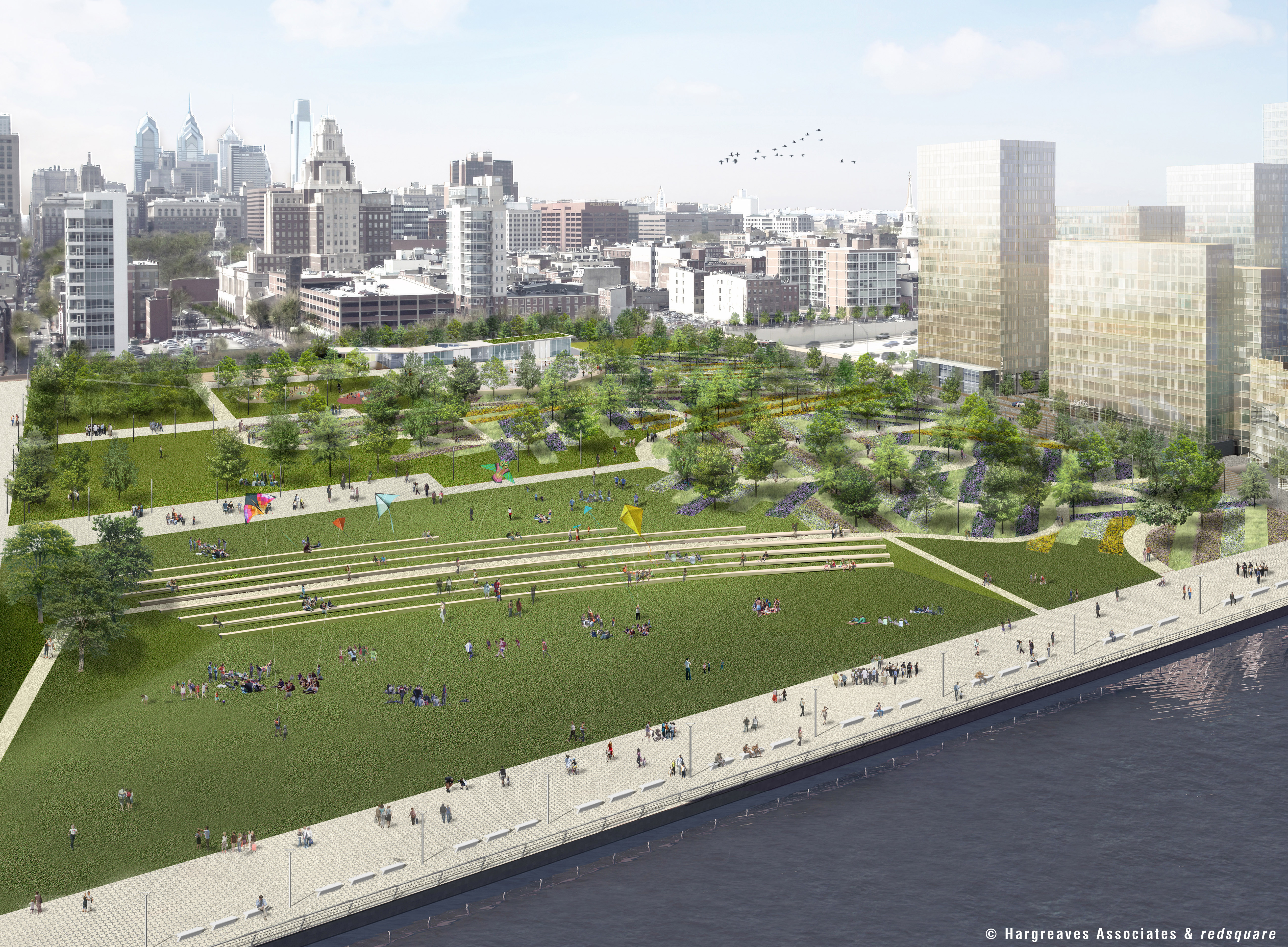Kenney budget puts $90 million toward Penn’s Landing park capping I-95

Funding for a large new waterfront park at Penn’s Landing will be tucked into Mayor Jim Kenney’s budget address this Thursday.
The mayor plans to announce a $90 million city commitment to capping I-95 and building an 11-acre expanse of greenery between Walnut and Chestnut streets. The project is meant to connect Center City with the waterfront. The administration expects this public project—estimated at $225 million—to spur adjacent private investment on a far larger scale.
“We have never met our potential when it comes to waterfront development,” said Mayor Kenney in an interview with PlanPhilly. “A lot of it has to do with a lot of the waterfront parcels being privately owned. But just concentrating on the central waterfront that we control, we’ve never maximized our potential. This will go a long way in doing that.”
The 2007 Civic Vision for the Central Delaware, a process led by PennPraxis*, was a first step toward that goal. It envisioned a new public park at Penn’s Landing and the Delaware River Waterfront Corporation (DRWC) fleshed out the idea in the Master Plan for the Central Delaware, adopted by the city in 2012. An intensive public engagement process and an initial engineering study refined the design, developed by the landscape architecture firm Hargreaves and Associates and were released in 2014.
The $90 million that Kenney is committing to the project will be doled out over six years. The rest of the $225 million—down from $250 million in earlier projections—is expected to come from the state and from philanthropic donors.
The mayor expects to make an announcement naming more specific sources soon. He describes Governor Tom Wolf and Secretary of Transportation Leslie Richards as being deeply committed to the project.
Kenney framed the I-95 cap, and the new park sloping down to the river, as part of his larger equity agenda. In other words, this centrally located mega-project would be a companion to the Rebuild Initiative, rather than a counterpoint.
“Growing up my parents would take us to the Jersey Shore for a week,” said Kenney. “Some of these young people and families don’t have an opportunity to leave the city at all. Their shore is the shoreline of the Delaware River, where you can cool off a bit, buy a pretzel for your kid, and enjoy for free what people want to do with their children.”
The city’s Director of Planning and Development, Anne Fadullon, emphasized how much private investment they expect the project to leverage. In 25 years after completion, she anticipates $1.6 billion in economic return for the city and 2,400 permanent jobs.
Fadullon did not commit to an exact timeline for the park’s construction.
“Right now, the project is in design and engineering so it will be a little bit of time before anybody sees anything happening specifically with the cap project,” said Fadullon. “But there’s a lot of things happening in anticipation. To prepare for it, you’re about to see the scissor ramps come down. There is a new elevator and stairway under construction right now.”
The mayor emphasized that much of the underutilized land along the Delaware riverfront is privately held. According to DRWC, only 10 percent of it is in public hands. The largest area by far is Penn’s Landing, which extends 28 acres.
The capping and park project thus offers an opportunity to use one of the city’s main leverage points on the waterfront. Kenney contrasted the project with past proposals to cap all of I-95, which he described as being unrealistically ambitious.
In recent years, there’s been more activity on the waterfront around Penn’s Landing, in an effort to raise the area’s profile as a public space and recast perceptions of the waterfront.
“For the last five years we’ve been working on projects north and south of Penn’s Landing to create a sense of momentum,” said DRWC president Tom Corcoran, citing the Spruce Street Harbor Park and the Race Street Pier as examples.
Kenney used his commitment to the park at Penn’s Landing to critique the highway construction and urban renewal policies of the mid-20th century. The mayor said that if he could have controlled those investments, he would have spent most of the public money used to expand the federal highway system on mass transit instead.
“I grew up in a neighborhood where literally thousands of homes were taken to build I-95,” said Kenney. “Thousands of families displaced and houses torn down. It was a very traumatic experience. We lost a whole segment of our history that we’ll never get back, for a superstructure that will never go away. It’s time to mitigate that intrusion and to cap it.”
*Note: PlanPhilly was created out of the 2006-2007 civic visioning process as a project of PennPraxis. PlanPhilly joined WHYY in 2015.
WHYY is your source for fact-based, in-depth journalism and information. As a nonprofit organization, we rely on financial support from readers like you. Please give today.





